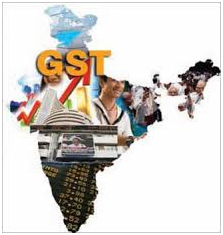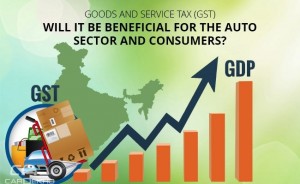In this blog post, Pramit Bhattacharya, a student of Damodaram Sanjivayya National Law University, gives a comprehensive analysis of the Goods and Service Tax Bill (GST), 2014 and its impact on the economic system of India.
With the proposal of the Goods and Service Tax (GST) Bill or officially the Constitution (122nd) Bill, 2014 in the Parliament, the government of India is seeking to remove all indirect service tax which is levied on the consumers by the Centre and the State and implement a national Value-Added Tax through the length and breadth of the country. The Government is looking forward to the GST by the end of 2016. The introduction of the GST will create a comprehensive and all-embracing tax base where, not taking in account some minimum exemption, almost all the goods and services will be taxable.
The introduction of GST will herald a new era in the Indian economic system. The introduction of the GST will give way to a common Indian market. It also seeks to reduce the cascading effect of indirect taxes which is at present prevalent in the current economic structure. In a nutshell, the introduction of GST will completely overhaul the current indirect tax system. Not only will it have a bearing upon the Tax structure, but it’ll also modify the Tax Computation, Compliance, tax incidences, and Reporting. GST will have a pervasive effect on the business operations, impacting almost all aspects including pricing of services and products, accounting and modification of the supply chain.
Understanding GST
GST is a consumption tax which is based on the value added concept. In simple terms, the consumer will have to pay the tax only once, with the price of the goods remaining the same. GST will eliminate the cascading effect of taxation which the consumers face under the current sales tax and service tax. Keeping the federal structure of governance in India, it has been proposed that both the Centre and the State will concurrently levy the GST (CGST and SGST). The basic principles would be the same for the CGST and the SGST and across SGSTs for separate states. It is also proposed that the GST will follow the destination principle, wherein the exports would be zero-rated, but the imports would be subject to tax payment. When the trade and commerce are within India, i.e., interstate, an integrated GST (IGST) will be applied (cumulative of SGST and CGST of the destination)
It has also been proposed that an additional tax of 1 % will be levied with respect to the supply of goods; in addition to the IGST. The revenue generated from this tax will be assigned to the origin state. This additional tax is proposed for the period of 2 years initially.[1]
Significant Features of the GST
- One of the most important characteristic of the GST is that the authority to make any laws or levy any taxes in the course of “interstate” commerce and trade will be vested only with the Central Government. The State will have authority only over “intra-sate” trade and commerce.
- An IGST will be levied on inter-state trade and commerce. In the case of import of goods, they’ll be subjected to both IGST and customs duty.
- GST will incorporate in itself-
At the Central Level-
- Central Excise Duty
- Additional Excise Duty
- Additional Custom Duty
- Service Tax
- Special Additional Duty
- Central Surcharge and Cess’
At the State Level-
- VAT
- Entertainment Tax (Entertainment Tax on Municipality, Panchayat and District level will be continued)
- Entry Tax
- Purchase Tax
- Luxury Tax
- Octroi
- Exemption from GST
- Alcoholic liquor supplied for human consumption
- Petroleum products like high-speed diesel, crude, aviation fuel, motor spirit, natural gas (Although they shall also be subject to GST if and when the GST Council notifies).
- GST may be levied to advertisements and newspapers.
- Stamp duties, typically imposed on legal agreements by the state, will continue to be levied by the States.
- The GST Council will be responsible for the administration of GST. The Council will act as an apex policy making body for GST, and the council will comprise of State and Central Ministers who hold the portfolios of the finance department.
- It has also been proposed to remove Octroi/Entry tax across India
Advantages of GST
- GST will provide a wider tax base. GST will also eliminate classification disputes.
- As mentioned earlier also, one of the major advantages of having GST will be to remove the multiplicity of taxes and the cascading effect.
- With the introduction of GST, compliance procedures will be simplified, and tax structure will make allowance for better regulations.
- The duality of administration of Centre and State taxes will be harmonized, and it’ll lead to the reduction of compliance and duplication cost.
- It is also proposed that the compliance procedure will be automated. This will lead to efficient working and also reduce errors.
- Exports will become more competitive as exports will be zero rated. More the exports, better the GDP.
Impact of GST
GST if introduced will stand out as one of the most significant fiscal reform in the economic structure of India. GST is expected to harmonize the administration of taxes at the Central and the State level and thus simplifying the structure of consumption taxes. A significant redistribution of tax across goods and services will also take place depending upon the final rate and base of GST. The services which under the current regime falls under both the Central and the State list will see a reduction in taxes levied on them, which in turn will increase demand. The supply chain of operations will also be fundamentally changed with the introduction of GST. Under the current regime, the supply chain is designed in such a way that the burden of Central Sales Tax is minimized. These designs are subprime from the economic and strategic point of view. The elimination of the Central Sales Tax will provide business houses to optimize their supply chain and reduce the costs.
Impact on manufacturing and retail sector
- Increased flexibility in obtaining credit on goods and services.
- Reduction in production and procurement cost due to the full credit of taxes on interstate sale.
- Imports will become cheaper due to credit on import taxes.
- Elimination of Entry tax along with additional compliances will reduce a huge burden.
Hospitality and Entertainment sector
- The multiplicity of taxes will be reduced as VAT, Service Tax, Luxury Tax and Entertainment Tax will be eliminated.
- Simplifies levy and valuation on composite transactions. Thus, will reduce litigation challenges and related costs faced by companies in this sector.
IT and telecom sector
- Classification disputes on software, SIM Cards, AMCs, and Franchise Fees will cease to exist.
- Levy and valuation on composition transaction will be made easier.
Service sector
- Better credits can be availed across various goods and services.
- No segregation will be done between manufacturing, trading and services for availing credit.
Banking and finance sector
- Interest on loans will be taxed under the GST.
- Credit pool will increase due to the availability of GST credits.
- The rise in tax rate from around 12% will increase to more than 20% which may increase the cost of banking and operations (negative impact).
Infrastructure and real estate
- Supplies o SEZs to be zero rated and hence SEZs will benefit a lot from GST.
- Under the GST regime, composite contracts may fall under the head of “services.”
- Total tax incidences will increase on certain product under the GST such as steel and cement.
GST is not a new tax, but a replacement tax. The major step forward which can be achieved by introduction of GST is the mechanism to mediate inter-state credit. The GST regimes focuses on a central compensation system. The integrated GST will replace the CST, with the originating state charging IGST on sale. Now, this IGST can be taken as a credit at the destination place, and can be used to pay IGST, CGST or SGST (in such order of preference). In simpler words, the loss which is caused to the destination state under the current regime by tax paid in another state which is being adjusted against tax payable to the destination state will be made good by the Centre. This will help in the growth of market across the individual state. The rationale behind such mechanism is to act as a catalyst for increased revenue and production. This system of input tax credit in inter-state sales is a major salutary feature of the proposed GST model.
All said and done; GST has still not seen the light of the day. The idea may seem innovative, but such innovation is not of present times. The idea for GST was conceived in the year 2000 and 16 years have passed, but no implementation of the idea has yet been done. If at all GST is implemented a study done by the National Council of Applied Economic Research (NCAER) also suggests that India will indeed make progress on implementation of GST and could expand India’s growth of gross domestic product by 0.9-1.7 %[2]. The removal of Central and State taxes will help in reducing taxes and will also aid in filing costs and expanding business in a profitable manner. This would attract more investors and as a result, the gross domestic production will increase. Simplification in tax norms through the implementation of GST can also help in improving tax compliance and increasing tax revenues.
Footnotes:
[1]http://www.ey.com/IN/en/Services/Tax/EY-goods-and-services-tax-gst
[2]http://www.referencer.in/GST/Files/GST_NCAER_Report.pdf
 Serato DJ Crack 2025Serato DJ PRO Crack
Serato DJ Crack 2025Serato DJ PRO Crack











 Allow notifications
Allow notifications



